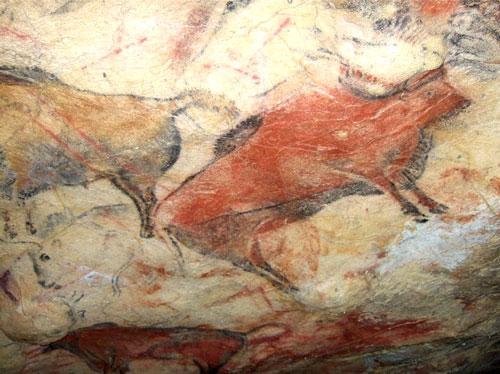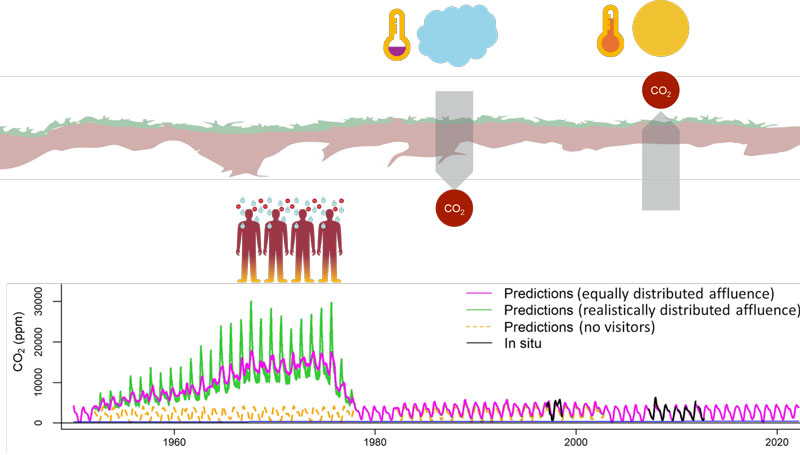Scientists develop a mathematical model to aid conservation efforts in the Altamira Caves

An interdisciplinary study in which both the National Museum of Natural Sciences (MNCN) and the Institute of Geology and Minerals, both part of CSIC, participated, together with the universities of Alicante, Almeria, and Toulouse (France), have developed a mathematical model which deals with the complex relations between the climate, the ground, rock, and human activities and their impact on environmental conditions within the Altamira Caves. The study, which is applicable to other subterranean caves, employed a global modelling technique in order to understand the past and predict future scenarios surrounding Co2 concentration in the cave. The results allow for measures to be established to continue conserving the cultural heritage of Altamira in anticipation of the climate changes that will foreseeably modify its environmental conditions.
They have reconstructed the gas concentrations in the cave since 1950 and the changes that, in the face of climate change, they will undergo until 2100.
"From the series of data obtained in the Altamira Caves between 1996 and 2012, we have used advanced mathematical modelling techniques to understand and to predict the fluctuation in the Co2 concentration in the atmosphere of the cavern" explained MNCN researcher Sergio Sánchez-Moral. "The key factors upon which the model is based are, measurements, in context of the temperature, the moisture of the exposed ground, and the temperature and concentration of Co2 within the cave" he continued. Additionally, by incorporating external data sources from time series of satellite images into the model, it has been possible to simulate the behaviour of the Co2 concentration in the cave under different climatic conditions and to validate the results with real data.

The team has developed the dynamic equations that control the temporal and spatial variability of gas, energy and matter exchange between the external environment and the subterranean environment. This approach has allowed them to develop the model that simulates and analyses the interactions between these factors and takes into account both internal and external influences on the cave's microclimate. According to Sanchez-Moral: “The mathematical model provides us with crucial information about the relationship and interaction between the external climate and the subterranean environment, which is key to maintaining the environmental stability of the cave and, therefore, to preserving the valuable cultural heritage it houses”.
The technique, which incorporates time series data from satellite imagery, is applicable to other caves.
The algebraic formula of the models obtained confirmed that the main drivers of the caves microclimate are external temperature, soil-rock moisture and human activity inside the cave. The results of the study highlight the significant impact of human activity in the cave, particularly intense during the period 1950-1970. “The high influx of visitors during this period of low external temperatures caused a large amount of CO2 to accumulate inside the cave, favouring the production of condensation on the ceiling and the subsequent corrosion of the rock that supports the paintings, making it essential to take measures to reduce the impact that visitors were producing,” says Soledad Cuezva, a researcher at IGME. In addition, the study projects future challenges, especially in the context of climate change, which will imply an increase in CO2 concentration and will aggravate the risks of corrosion and deterioration of the artistic representations.
Preservation of Heritage
Cave paintings are the first thing to arouse society's interest in conserving cave ecosystems. However, beyond the cultural component, caves are environments in which species adapted to very specific environmental conditions survive and which contain geological formations, speleothems, which allow us, among other things, to reconstruct the climate of the past. Protecting both the biology and geology of these areas requires the development of sustainable management practices.
This research highlights the importance of understanding and monitoring the dynamics of the cave atmosphere, considering both natural and anthropogenic influences. In this sense, the integration of different disciplines is fundamental to design conservation strategies that mitigate potential risks to the natural and cultural heritage of caves.
Date
Wednesday, 29 May 2024Publicado en
Scientific reportsInvestigador
Sergio Sánchez del MoralReferencias
M. Sáez, D. Benavente, S. Cuezva, M. Huc, Á. Fernández‑Cortés, A. Mialon, Y. Kerr, S. Sánchez‑Moral y S. Mangiarotti. (2024) Scenarios for the Altamira cave CO2 concentration from 1950 to 2100. Scientific reports. DOI: https://doi.org/10.1038/s41598-024-60149-9






